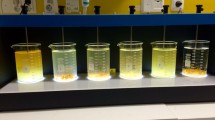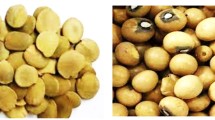Abstract
The aim of this work was to evaluate the role of three biopolymers used as coagulant–flocculant aids in the treatment of a high-load cosmetic industry wastewater (WW) located in Mexico. Discussion is based on a surface response methodology. When using guar, locust bean gum, and Opuntia mucilage, conductivity and turbidity removals as high as 20.1 and 67.8 % were found, respectively. Chemical oxygen demand (COD) removals as high as 38.6 % were observed. The maximum removal efficiency was found for mucilage, with 21.1 mg COD/mg polymer. At the end of the process, pH was in the range of 5.8–7.3 for an initial wastewater pH value of 5.6. The production of sludge was very dependent on the WW organic load. An analysis of some metal content in the sludges is presented. From the response surface analysis, it was observed that the parameter which strongly affected the removal of COD, turbidity, oil and greases (O&G), and the amount of sludge including their metal contents was the polymer dose. Only in the case of O&G removal was a combination of dose–wastewater organic load responsible for the removals. The values of R 2 for the correlation process were between 0.5451 (O&G) and 0.7989 (COD). The p values for the different expressions were between 0.1985 (COD) and 0.7195 (O&G). The values of adequate precisior (AP) indicate how feasible it is to use the surface response analysis (AP > 4). Most of the analysis indicated that AP > 4, except in the case of the O&G removal analysis where AP = 2.9.



Similar content being viewed by others
References
APHA, AWWA, WPCF. (1989). Standard methods for the examination of waters and wastewaters (17th ed.). Washington, DC: American Public Health Association, American Water Works Association, Water Pollution Control Federation.
Beltrán, M., Marcilla, A. (2011). Curso Tecnología de Polímeros. Universidad de Alicante. Consulted January 25, 2011.
Beltran-Heredia, J., & Sanchez-Martín, J. (2009). Removal of sodium lauryl sulphate by coagulation/flocculation with Miringa oleifera seed extract. Journal of Hazardous Materials, 164, 713–719.
Bhatia, S., Othman, Z., & Ahmad, A. (2006). Palm oil mill effluent pretreatment using Moringa oleifera seeds as an environmentally friendly coagulant: laboratory and pilot plant studies. Journal of Chemical Technology and Biotechnlogy, 81(12), 1852–1858.
Carballa, M., Omil, F., & Lema, J. (2005). Removal of cosmetic ingredients and pharmaceuticals in sewage primary treatment. Water Research, 39, 4790–4996.
Cárdenas, A., Higuera-Ciapara, I., Goycoolea, F. M. (1997). Rheology and aggregation of cactus (Opuntia ficus-indica) mucilage in solution. J.PACD, pp. 152–159.
Carpinteyro-Urban S., Yañez, J., Torres, L. G. (2010). Coagulation flocculation or wastewaters employing guar, locust bean and mesquite gums, as well as Opuntia mucilage. Proceedings of the 2nd IWA Mexico Young Water Professional Conference, Querétaro, Mexico.
Dakia, P. A., Blecker, C., Robert, C., Wathelet, B., & Paquot, M. (2008). Composition and physicochemical properties of locust bean gum extracted from whole seeds by acid or water dehulling pre-treatment. Food Hydrocolloids, 22, 807–818.
Diaz, A., Rincon, N., Escorihuela, A., Fernandez, N., Chacin, E., & Foster, C. F. (1999). A preliminary evaluation of turbidity removal by natural coagulants indigenous to Venezuela. Process Biochemistry, 35(3–4), 391–395.
Gupta, B. S., & Ako, J. E. (2005). Application of guar gum as a flocculant aid in food processing and potable water treatment. European Food Research and Technology, 221, 746–751.
Jern, W. (2006). Industrial wastewater treatment. England: Imperial College Press. 25 pp.
Lopez-Franco, Y., Goycoolea, F. M., Valdez, M. A., & Calderón de la Barca, A. M. (2006). Goma de mezquite: una alternativa al uso industrial. Interciencia, 31(3), 183–188.
Miller, S. M., Furgate, E. J., Oyanedel, C. V., Smith, J. A., & Zimmerman, J. B. (2008). Toward understanding the efficacy and mechanism of Opuntia spp. as a natural coagulant for potential application in water treatment. Environmental Science and Technology, 42(12), 4274–4279.
Mishra, A., & Bajpai, M. (2005). Flocculation behaviour of model textile wastewater treated with a food grade polysaccharide. Journal of Hazardous Materials, B118, 213–217.
Montgomery, D. (1991). Diseño y Análisis de Experimentos. Grupo Editorial Iberoamérica.
PROSEA (2010). Retrieved 5th November 2010 from http://www.prosea.lipi.go.id/.
Sanghi, R., Bhattacharya, B., Dixit, A., & Singh, V. (2006). Ipomea dasysperma seed gum: an effective natural coagulant for the decolorization of textile dye solutions. Journal of Environmental Management, 81(1), 36–41.
Sanghi, R., Bhattacharya, B., & Singh, V. (2006). Use of Cassia javahikai seed gum and gum-g-polyacrylamide as coagulant aid for the decolorization of textile dye solutions. Bioresource Technology, 97(10), 1259–1264.
Sincero, A. P., & Sincero, G. A. (2003). Physical chemical treatment of water and wastewater. UK: IWA Publishing.
Singh, R. P., Tripathy, T., Karmakar, G. P., Rath, S. K., Karmakar, N. C., Pandey, S. R., Kannan, K., Jain, S. K., & Lan, N. T. (2000). Novel biodegradable flocculants based on polysaccharides. Current Science, 78(7), 798.
Srivastava, M., & Kapoor, V. P. (2005). Seed galactomannans: an overview. Chemistry & Biodiversity, 2, 295–317.
Torres, L. G., Jaimes, J., Mijaylova, P., Ramirez, E., & Jimenez, B. (1996). Coagulation–flocculation pretreatment of high-load chemical-pharmaceutical industry wastewater: mixing aspects. Water Science and Technology, 36(2–3), 225–262.
Torres, L. G., Belloc, C., Vaca, M., Iturbe, R., & Bandala, E. R. (2009). Coagulation–flocculation process applied to wastewaters generated in hydrocarbon-contaminated soil washing: interactions among coagulant and flocculant concentrations and pH value. Journal of Environmental Science and Health Part A, 44, 1449–1456.
Wells, M. L. S., Baloyi, N., & Deglon, D. A. (2007). Oil removal from industrial wastewater using flotation in a mechanically agitated flotation cell. Water SA, 33(4), 453–457.
Williams, P. (2007). Handbook of industrial water soluble polymers. Oxford: Blackwell Publishing.
Yaseen, E. I., Herald, T. J., Aramouni, F. M., & y Alavi, S. (2005). Rheological properties of selected gum solutions. Food Research International, 38, 111–119.
Zhang, J., Zhang, F., Luo, Z., & Yang, H. (2006). A preliminary study on cactus as coagulant in water treatment. Process Biochemistry, 41, 730–733.
Acknowledgments
This work was supported by the ICyT-DF grant PICSO10-8 as well as the SIP-IPN 2011933 grant. Wastewaters were kindly donated by an anonymous Cosmetic Industry located in Mexico. Sandra Carpinteyro-Urban thanks a scholarship received by CONACyT for MSc studies. The authors thank the suggestions made by the two anonymous reviewers, which improved the manuscript quality.
Author information
Authors and Affiliations
Corresponding author
Rights and permissions
About this article
Cite this article
Carpinteyro-Urban, S., Vaca, M. & Torres, L.G. Can Vegetal Biopolymers Work as Coagulant–Flocculant Aids in the Treatment of High-Load Cosmetic Industrial Wastewaters?. Water Air Soil Pollut 223, 4925–4936 (2012). https://doi.org/10.1007/s11270-012-1247-9
Received:
Accepted:
Published:
Issue Date:
DOI: https://doi.org/10.1007/s11270-012-1247-9




